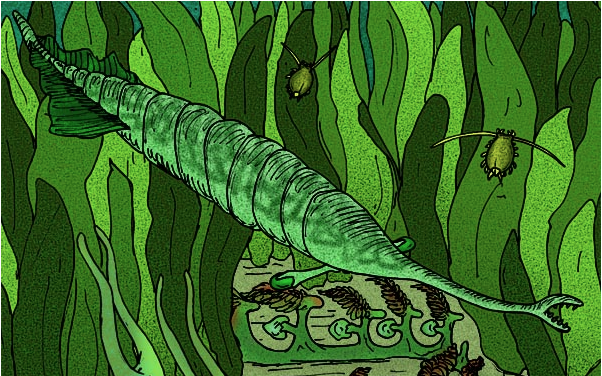Tully Monster: Weirdness Defined
A representation of a Tully Monster doing whatever it is they did.
Tullimonstrum gregarium, commonly known as the “Tully Monster”, is undoubtedly one of the strangest creatures known to science. It was a marine animal roughly the size and shape of water bottle, with fins on its posterior similar to those of a cuttlefish or squid, eyestalks, and a proboscis several inches long that ends in a mouth with small, sharp teeth. Even stranger, it is composed of almost no hard parts, meaning we are very lucky to have discovered fossils of it at all. This strange combination of features defied easy classification until very recently.
The “Tully Monster” was first discovered by an amateur paleontologist named Francis Tully. He first uncovered it in 1958 in the coal mining pits of Northeastern Illinois, but it was not officially described until 1966. By this point, Tully and other collectors had extracted nearly 2,000 “Tully Monsters” in the Mazon Creek Formation to which the mining pits belonged. These pits have also produced thousands of other extraordinarily high quality marine fossils. They are of a rare category of formations called Lagerstätten, a German term meaning “Storehouse rock”. Lagerstätten most often occur in swampy or coastal environments, but in all cases they are the result of rapid burial in layers of soft, silty substrate that contains at least one of various chemicals that slow decomposition. This combination causes many organisms to be preserved in very high detail, often including the imprints of soft tissue that are usually not preserved. This causes the volume, diversity, and level of detail of fossils to be far higher in Lagerstätten than in other formations. This provides a very detailed look at that specific prehistoric environment.
From the Mason Creek formation we can see that tullimonstrum lived in warm, shallow coastal seas in the Carboniferous, 330 million years ago. Diverse other organisms including bottom dwelling sponges and bivalves indicate a rich, reef like environment. Coal deposits indicate that this environment bordered coastal forests, perhaps similarly to a mangrove forest. It was an environment with diverse forms of fish, crustaceans, and invertebrates, but almost no amphibians or land invertebrates. This indicates that though the environment was coastal it did not contain a significant amount of solid ground. The “Tully Monster” was in the average size for a swimming creature in this environment, and seems to have been very common. Its sharp teeth may indicate that it was predatory, and some paleontologists believe that it used its proboscis to probe narrow crevices and dig the seafloor in search of small crustaceans and other bottom dwellers. However, it was eclipsed by many large predators such as sharks, armored plated fish, and sea scorpions. Its position as a major predator is also questionable because it is one of the most common species found in Mason Creek, indicating that it may have been a shoaling animal. It would have been a surreal sight to see a swarm of these strange creatures drifting through a mangrove forest, but like many things about the “Tully Monster” it’s true life habits may never be known.
One thing paleontologists had long assumed was unknowable about the “Tully Monster” was its place in the tree of life. With very few features that link it to modern creatures, Tullimonstrum has been a challenging creature to classify. Some interpretations linked it to worms, slugs, the ancestors of cephalopod, and even sea cucumbers. However, a recent study taking advantage of the vast numbers of “Tully Monsters” collected over the years has revealed that it was in fact a simple vertebrate. Computer imaging and scanning electron microscopes were used to examine the fossils in extreme detail, and revealed primitive a primitive spinal cord called a notochord. Unlike the spinal column in most vertebrates, the notochord is composed entirely of cartilage surround the nerves. In addition, the “Tully Monster” had simple gills that very closely resemble those of one type of modern fish: the lamprey. The lamprey is a primitive jawless cartilaginous fish with a body similar to an eel and a mouth that resembles a toothed suction cup. Its gills appear as simple holes down the length of its body, and it seems the “Tully Monster” had these too. This is powerful evidence that it is a close relative of the lamprey and therefore a true, if primitive, fish.
The facts of the “Tully Monster’s” discovery make it not only an interesting animal on its own merit, but opens up some fascinating implications. It is the only animal like it yet known, but it certainly is not the only one. This is especially true considering that its preservation was a very unlikely event. In light of this, it is currently impossible to predict just how diverse and bizarre extinct animals can be. Though Tullimonstrum gregarium seems to be a very aberrant creature, it is undoubtedly only the tip of the iceberg in strangeness.

